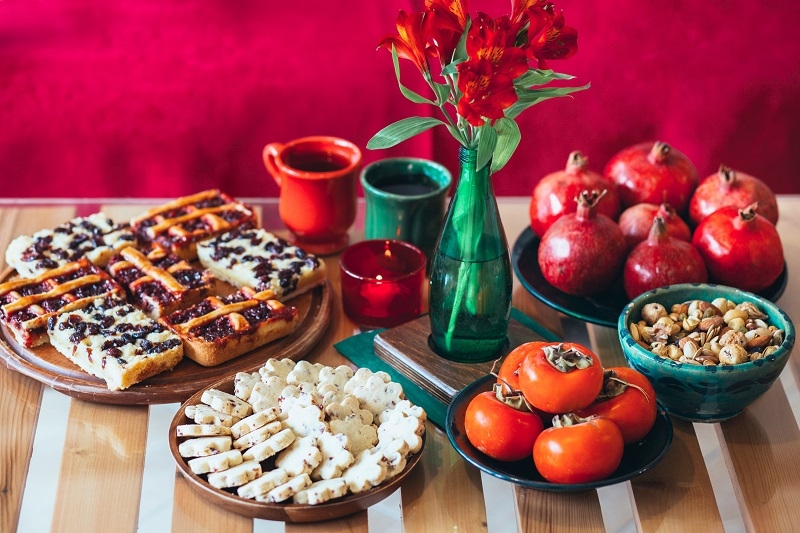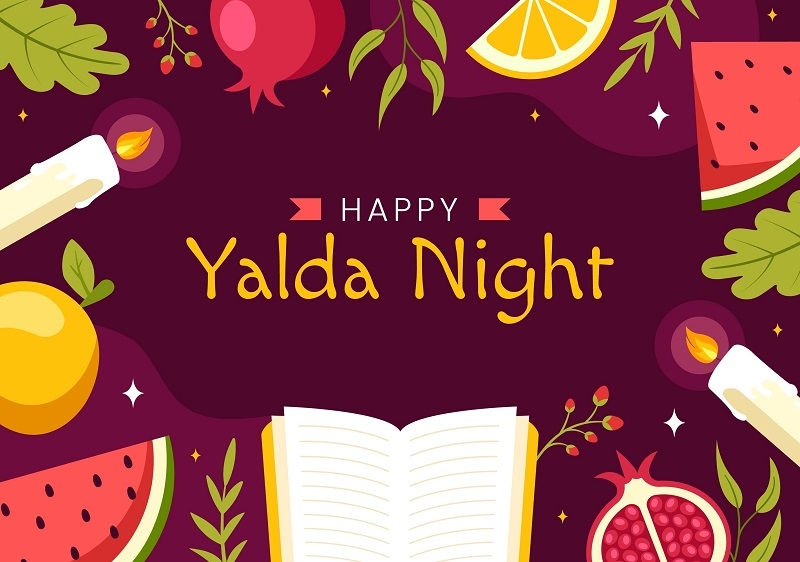
The most magical thing about the longest night of the year in Iran is the night is Shab-e Yalda. It is a unique celebration of light, warmth, and togetherness with families gather to read poetry, share stories, and reflect on the year. However, one thing that always has the spot light is Yalda night food.
It is not just about eating, but it is about honoring the Iranian heritage through flavor. The taste, colors, and smell on the table display special stories that have passed down for generations. From ancient Zoroastrian roots to modern Persian homes, Shab-e Yalda carries the warmth of tradition — and every dish plays a role in that journey.
Before diving into the flavors, it's important to understand the deeper customs that give Yalda night food its meaning. Shab-e Yalda marks the winter solstice that is the longest night before the days start growing longer. It is also seen as a celebration of the victory of light over darkness.
Families gather under soft blankets, surrounding a heated table also known as ‘Korsi’, and recite Hafez poetry aloud. The evening is filled with storytelling and laughter that creates an extremely warm mood.
This feeling makes the whole environment vibrant with each dish being symbolic and rooted to ancient beliefs about health, good fortune and love.
When it comes to shab e yalda foods, color and symbolism matter as much as taste. The red tones of pomegranates and watermelon are believed to represent the rising sun, warmth, and life itself.
Here are some of the most essential items seen on a Yalda night table:
These foods are shared not just for flavor, but as an extension of ancestral wisdom — a quiet but powerful nod to continuity.
Top Pick: Persian Street Food: Explore Iran's Most Popular Snacks

Some families go beyond fruit and nuts, preparing full meals that honor traditional foods for shab e yalda. These meals vary by region, but a few beloved dishes stand out for their history and connection to winter.
One classic is Ash-e Reshteh, a thick noodle and bean soup rich with herbs and flavor. It’s comforting, filling, and perfect for cold nights. Then there’s Sabzi Polo ba Mahi — herb rice with fish — often served to symbolize wealth and freshness for the coming year.
Another favorite is Khoresht-e Fesenjan, a stew made with ground walnuts and pomegranate molasses. Its deep, tangy sweetness fits the season perfectly.
Each dish not only warms the stomach but links generations. Grandmothers teaching grandchildren how to stir, season, and serve — it's tradition passed down not on paper, but by hand.
Some of the best Persian food recipes for Yalda night are surprisingly simple. They rely more on patience and balance than complexity.
Made with yellow split peas, ground beef or lamb, fresh herbs, and of course, pomegranate. Tart, savory, and unforgettable.
Scented with rose water and topped with cinnamon. Sweet and spiritual.
A dish of jeweled rice with tart barberries, often served with chicken. Symbolizes brightness in dark times.
These recipes are not just food; they’re memory containers. They remind people of winter nights spent beside their elders, of laughter echoing through small kitchens, and of hands stained red from pomegranate seeds.
The beauty of Yalda night food lies in its roots. These are not trendy dishes or modern fusions — they are traditional Persian food in its purest form. No shortcuts. No replacements.
In every region of Iran, you’ll find slight variations: different herbs, techniques, or spices. But the spirit remains unchanged. Whether it’s rice steamed to perfection or stews simmered for hours, every bite speaks of time, love, and home.
Even desserts carry stories — like Halva, made from flour, sugar, rose water, and saffron. Often shaped with ornate patterns, it represents nourishment and beauty.
Many dishes enjoyed on Yalda are also considered popular Persian food throughout the year. But they take on extra meaning during this night of warmth and gathering.
Here are a few more beloved items seen on Yalda tables:
A golden crusted rice cake often layered with chicken or vegetables.
Grape leaves stuffed with rice and herbs which can be served warm or cold.
An herb-packed Persian frittata that is perfect as a light side or main.
Rice with toasted noodles and dates — a symbolic dish believed to ‘untangle’ life’s knots.
Each of these dishes has traveled through time, bridging ancient customs with modern kitchens.
To make the celebration truly memorable, many households stick to the best Persian food recipes that balance ease and flavor. The idea is not just about showing off culinary skill — it’s about connection.
Cooked slowly, shared generously and served with a deep meaning.
Here’s a suggested Yalda night menu for a full table:
Preparing these dishes is more than following a recipe — it’s a form of cultural storytelling.
Yalda night food invites people to slow down, enjoy and relax with their family while experience their history. It is not just a table full of dishes, but a table full that is filled memories of their ancestors and poetry.
It does not matter if you celebrate the Shab e Yalda in Tehran, Shiraz, or in your apartment. The act of preparing and sharing the foods will always keep the tradition alive.
This content was created by AI